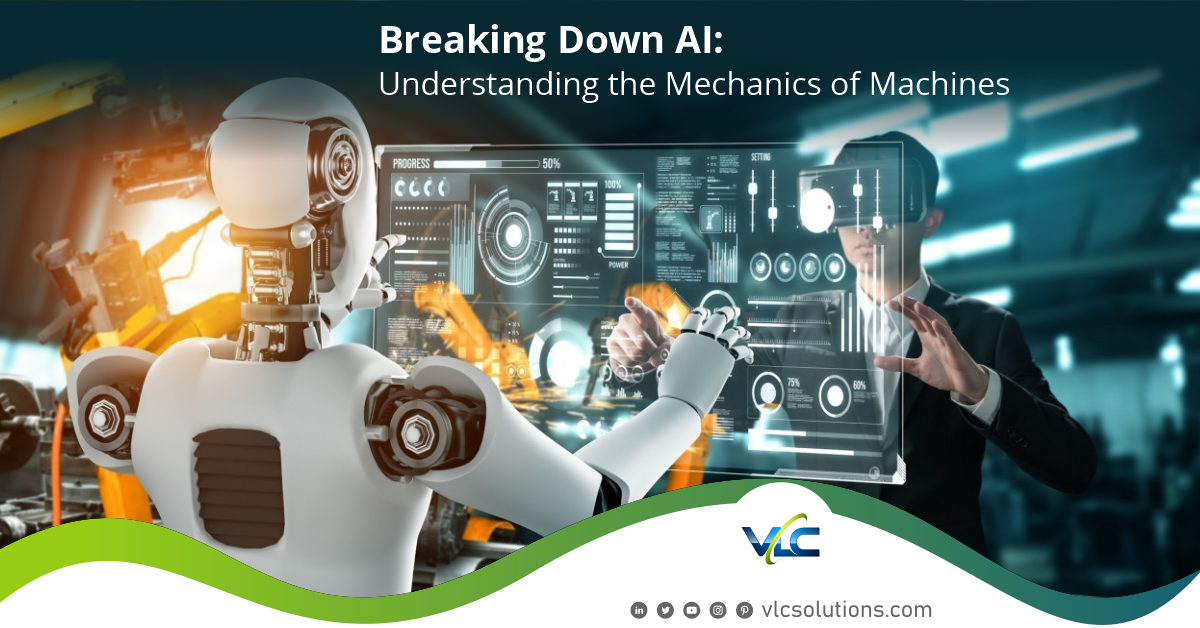Breaking Down AI: Understanding the Mechanics of Machines
The term Artificial intelligence (AI) has become universal, shaping industries and changing the way we interact with technology. Yet, for some, the fundamentals behind AI still need to be clarified. In this blog, we’ll dissect the fundamentals of AI, shedding light on its inner workings and its transformative potential for businesses worldwide.
The Basics of AI:
At its core, AI operates as a simulation of human intelligence, allowing machines to perform tasks that traditionally require human cognitive functions. For businesses, grasping the basics of AI is crucial. By using algorithms and massive datasets, AI assists in automating processes, making predictions, and solving complex problems. This foundational understanding empowers businesses to explore the potential applications of AI in streamlining operations, optimizing decision-making, and gaining a competitive edge. Companies can analyze vast datasets with AI-powered tools and algorithms to extract meaningful insights. This analytical prowess translates into informed decision-making, reducing operational costs and increasing productivity. Industries adopting AI witness significant improvements in customer satisfaction, operational efficiency, and revenue growth.
AI in Business: A Catalyst for Growth
Integrating AI technologies into business operations has yielded remarkable results, driving efficiency, innovation, and competitive advantage. According to recent studies, businesses that adopt AI experience a significant increase in productivity, with estimates suggesting a 40% reduction in operational costs and a 50% increase in business output.
AI is adept at automating repetitive tasks, freeing human resources to focus on higher-value activities. For example, in customer service, AI-powered chatbots can handle routine inquiries, providing immediate assistance to customers while reducing the workload for human agents. This improves customer satisfaction and allows businesses to operate more efficiently.
Enhancing Decision-Making: The Power of AI
One of AI’s most compelling applications is its ability to analyze vast amounts of data and derive actionable insights. By harnessing machine learning algorithms, businesses can make informed decisions based on data-driven predictions, leading to improved outcomes and strategic advantages. Studies indicate that AI-powered decision-making can result in a 73% increase in customer satisfaction and a 69% boost in operational efficiency.
For example, in retail, AI algorithms analyze customer data to identify trends and preferences, enabling businesses to tailor their offerings and marketing strategies accordingly. This drives sales and enhances the overall customer experience, fostering loyalty and repeat business.
Transforming Industries: AI’s Impact Across Sectors
AI is reshaping industries, driving innovation, and accelerating progress from healthcare to finance. In healthcare, AI-powered diagnostic tools revolutionize patient care, improve accuracy, and facilitate early disease detection. Similarly, in finance, AI algorithms optimize investment strategies, detect fraudulent activities, and enhance customer experiences, leading to significant cost savings and revenue growth.
In manufacturing, AI-powered predictive maintenance systems analyze equipment data to detect potential issues before they occur, minimizing downtime and maximizing efficiency. This proactive approach to maintenance not only reduces costs but also improves overall productivity and reliability.
The Emergence of Generative AI:
As we explore the frontier of Generative AI (GenAI), we discover new avenues for creativity and innovation in the business world. GenAI enables machines to generate content, such as images, music, and text, with human-like creativity, opening up exciting possibilities for industries ranging from entertainment to design. For example, in advertising, AI-powered tools can generate personalized ad content based on customer demographics and preferences, leading to higher engagement and conversion rates.
Similarly, in product design, AI algorithms can generate prototypes and concepts, allowing businesses to explore new design possibilities and iterate rapidly. Backed by market statistics, the importance of diverse and quality datasets must be balanced. Recent figures indicate that businesses with access to extensive and varied data witness a 25% improvement in AI model outcomes. According to recent market insights, pre-processing, the unsung hero of data preparation, contributes to a 30% increase in the efficiency of generative AI models.
Conclusion:
With the power of artificial intelligence, companies can open up their hidden potential, driving efficiency, productivity, and profitability. A recent survey found that organizations leveraging AI achieve an average of 39% increase in revenue and 37% reduction in costs. As we look to the future, embracing AI will be paramount for businesses seeking to remain competitive in a rapidly evolving landscape. By investing in AI talent and infrastructure, companies can position themselves for long-term success, driving innovation and growth in the digital age.
